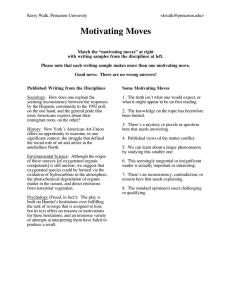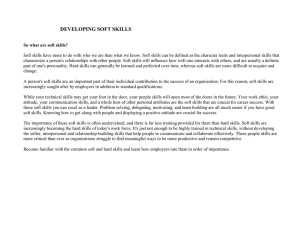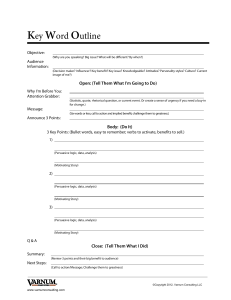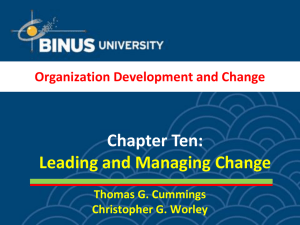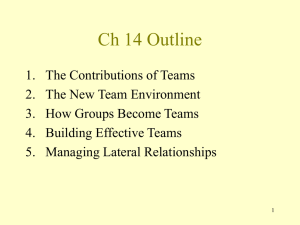Session 9 MOTIVATING FOR PERFORMING – Manajemen Umum Mata kuliah : A0012
advertisement
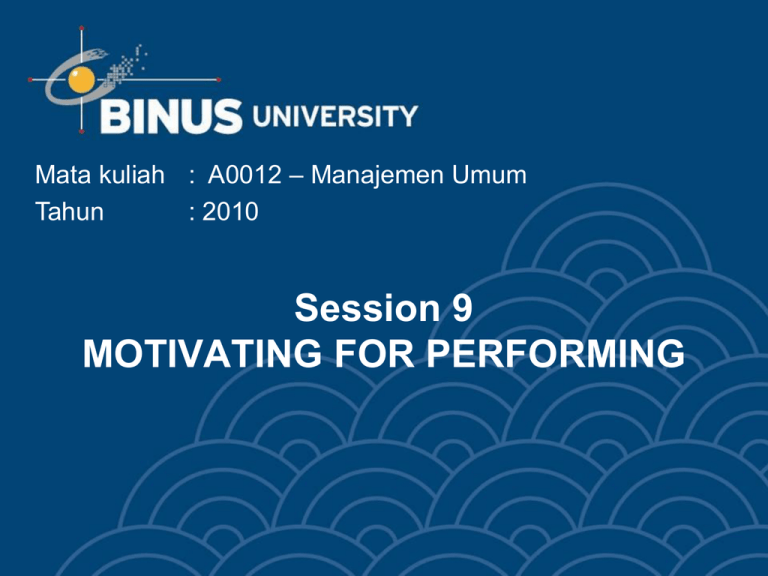
Mata kuliah : A0012 – Manajemen Umum Tahun : 2010 Session 9 MOTIVATING FOR PERFORMING Learning Objectives • After studying Chapter 13, you will know: – – – – – – – – 13-2 the kinds of behaviors managers need to motivate in people how to set challenging, motivating goals how to reward good performance the key beliefs that affect people’s motivation the ways in which people’s individual needs affect their behavior how to create a motivating, empowering job how people assess fairness the causes and consequences of a satisfied workforce Outline Materi • Setting Goals • Reinforcing Performance • Performance-Related Beliefs • Understanding People’s Needs • Designing Motivating Jobs • Achieving Fairness • Job Satisfaction Bina Nusantara Motivating For Performance • Motivation – forces that energize, direct, and sustain a person’ efforts – highly motivated people, with adequate ability and understanding of the job, will be highly productive – managers must know what behaviors they want to motivate people to exhibit 13-4 • Goal setting theory Setting Goals – people have conscious goals that energize them and direct their thoughts and behaviors toward one end • Goals that motivate – goals should be acceptable to employees – goals should be challenging but attainable – goals should be specific, quantifiable, and measurable • Limitations of goal setting – individualized goals create competition and reduce cooperation – single productivity goals interfere with other dimensions of performance 13-5 Performance-Related Beliefs • Expectancy theory – proposes that people will behave based on their perceived likelihood that their effort will lead to a certain outcome and on how highly they value that outcome • expectancy - employees’ perception of the likelihood that their efforts will enable them to attain their performance goals • instrumentality - perceived likelihood that performance will be followed by a particular outcome • valence - value an outcome holds for the person contemplating it – for motivation to be high, expectancy, instrumentalities, and total valence of all outcomes must all be high 13-6 Performance-Related Beliefs (cont.) • Expectancy theory (cont.) – managerial implications of expectancy theory • increase expectancies • identify positively valent outcomes • make performance instrumental toward positive outcomes 13-7 Basic Concepts Of Expectancy Theory Effort Performance Expectancy 13-8 Outcome Instrumentality • Content theories Understanding People’s Needs – indicate the kinds of needs that people want to satisfy – the extent to which and the ways in which a person’s needs are met or not met affect her/his behavior on the job • Maslow’s need hierarchy – human needs are organized into five major types • • • • • 13-9 physiological - food, water, sex, and shelter safety or security - protection against threat and deprivation social - friendship, affection, belonging, and love ego - independence, achievement, freedom, recognition, and self-esteem self-actualization - realizing one’s potential Understanding People’s Needs (cont.) • Maslow’s need hierarchy (cont.) – postulates that people satisfy these needs one at a time, from bottom to top • people motivated to satisfy lower needs before they try to satisfy higher needs • once satisfied, a need is no longer a powerful motivator – not altogether accurate theory of human motivation – nonetheless, made three major contributions • identified important need categories • helped to think in terms of lower- and higher-level needs • increased salience of personal growth and self-actualization 13-10 Understanding People’s Needs (cont.) • Alderfer’s ERG theory – postulates that people have three basic need sets • Existence needs - material and physiological desires • Relatedness needs - involve relationships with other people • Growth needs - motivate people to productivity or creativity – postulates that several different needs can be operating at once – has greater scientific support than Maslow’s hierarchy • both theories remind managers of the types of reinforcers or rewards that can be used to motivate people 13-11 Comparison Of Maslow’s Need Hierarchy And ERG Theory 13-12 Understanding Poeple’s Needs (cont.) • McClelland’s needs – achievement - strong orientation toward accomplishment, and obsession with success and goal attainment – affiliation - strong desire to be liked by other people – power - desire to influence or control other people • personalized power - negative force – expressed through the manipulation and exploitation of others • socialized power - channeled toward the constructive improvement of organizations and societies • Need theories: International perspectives – need importance varies from country to country – not all people are motivated by the same needs 13-13 Designing Motivating Jobs • Rewards may be available from the nature of the job – extrinsic reinforcers - reinforcement provided to a person by the boss, the company, or some other person – intrinsic reward - derived directly from performing the job itself • essential to the motivation underlying creativity – the result of a challenging problem – the result of work that is exciting in and of itself – ‘mechanistic’ approach to job design - characterizes a demotivating job • highly specialized, simple and routine • results in employee dissatisfaction, absenteeism, and turnover 13-14 • Job rotation Designing Motivating Jobs (cont.) – changing from one routine task to another to alleviate boredom • can benefit everyone when done properly • Job enlargement – giving people additional tasks at the same time to alleviate boredom • additional tasks at the same level of responsibility • Job enrichment – changing a task to make it inherently more rewarding, motivating, and satisfying • adds higher levels of responsibility 13-15 Designing Motivating Jobs (cont.) • Herzberg’s two-factor theory – distinguished between two broad categories of factors that affect people working on their jobs • hygiene factors - characteristics of the workplace – make people unhappy – will not make people truly satisfied • motivators - characteristics of the job itself – when present, jobs presumed to be both satisfying and motivating – theory has been widely criticized – nevertheless, highlights the distinction between extrinsic and intrinsic rewards • reminds managers that worker motivation depends on more than extrinsic rewards 13-16 Designing Motivating Jobs (cont.) • The Hackman and Oldham model of job design – well designed jobs produce three critical psychological states • meaningfulness - believe that work is important to other people • responsibility - feel personally responsible for how the work turns out • knowledge of results - know how well the job was performed – psychological states produced by five core job dimensions • • • • • 13-17 skill variety - different job activities involving several skills task identity - completion of a whole, identifiable piece of work task significance - important impact on the lives of others autonomy - independence and discretion in making decisions feedback - information about job performance Designing Motivating Jobs (cont.) • The Hackman and Oldham model of job design (cont.) – effective job enrichment increases all five core dimensions – effectiveness of a job enrichment program depends on a person’s growth need strength • growth need strength - degree to which individuals want personal and psychological development 13-18 The Hackman And Oldham Model Of Job Design Core Job Characteristics Skill Variety Task Identity Task Significance Autonomy Feedback From Job Critical Psychological States Meaningfulness of Work Responsibility for Work Outcomes Knowledge of Results MODERATORS Knowledge and Skill Growth Need Strength 13-19 Outcome s High Internal Motivation High Growth Satisfaction High Job Satisfaction • Empowerment Designing Motivating Jobs (cont.) – process of sharing power with employees – enhances beliefs about being influential contributors • • • • employees perceive meaning in work employees feel competent employees derive a sense of self-determination employees believe they have an impact on important decisions – empowering environment • • • • 13-20 provides information required to perform at one’s best knowledge available about how to use the information employees have the power to make decisions employees receive rewards for contributions Actions That Empower Employees Increase signature authority at all levels Reduce the number of approval steps Provide more freedom of access to people Specific Actions To Empower Provide more freedom of access to resources 13-21 Reduce the number of rules Assign nonroutine jobs Allow independent judgment Define jobs more broadly as projects • Equity theory Achieving Fairness – people assess how fairly they have been treated according to two key factors • outcomes - various things the person receives on the job • inputs - contributions the person makes to the organization – people expect the outcomes they receive to be proportional to the inputs they provide • people also pay attention to the outcomes and inputs of others • Assessing equity • equity exists when the ratios are equal Outcomesperceptions or beliefs Outcomes • assessments of equity are subjective Their own versus Others' Inputs 13-22 Inputs Achieving Fairness (cont.) • Restoring equity – inequity causes dissatisfaction and leads to attempts to restore balance to the relationship – a variety of behavioral and perceptual options may be used to restore equity • alter Person’s ratio – reduce inputs - give less effort, perform at lower levels, quit – increase outcomes - request higher grade, better pay • alter Other’s ratio – decrease outcomes – increase inputs 13-23 Achieving Fairness (cont.) • Fair process – procedural justice - using a fair process in decision making and making sure others know that the process was as fair as possible – fair processes make unfair outcomes more palatable • • • • 13-24 explain how a decision is made make an unbiased decision offer a chance to voice complaints collaborate in making decision Job Satisfaction • Correlates of job satisfaction – job satisfaction is unrelated to job performance – the greater the job dissatisfaction: • • • • • • • 13-25 the higher turnover the higher absenteeism the lower corporate citizenship the more grievances and lawsuits the higher the probability of a strike the more likely that stealing and/or vandalism will occur the poorer the mental and physical health of the workers Job Satisfaction (cont.) • Quality of work life (QWL) – programs designed to create a workplace that enhances employee well-being – organizations differ drastically in their attention to QWL • Psychological contracts – a set of perceptions of what employees owe their employers, and what their employers owe them • has important implications for employee satisfaction/motivation 13-26 Benefits provided by the organization versus Benefits promised by the organization Contributions provided by the employee Contributions promised by the employee
